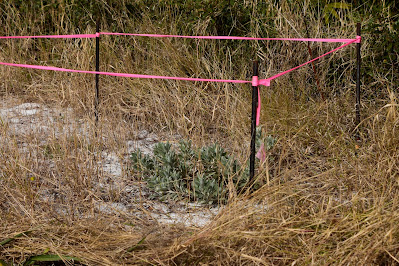One of the few lupines to survive the misguided fire lane discing last year has begun to bloom.
This is, I think, the first time a plant of this species has grown to maturity and bloomed in three years.
The fact that it has bloomed calls for a modified management plan for the area around the northern lupine planting area.
When the lupine nears the end of its flowering period, it ejects seeds into the surrounding landscape. That means the disturbed soil around the plant should not be disturbed by a tractor crew because it will prevent new plants from sprouting.
This is a big deal for an endangered species growing at only a handful of locations on the planet.
This discussion needs to occur soon. There are alternative routes around the planting area if you keep your eyes open. Besides, it might help to get rid of the Cape Honeysuckle along the outer fire lane.


















